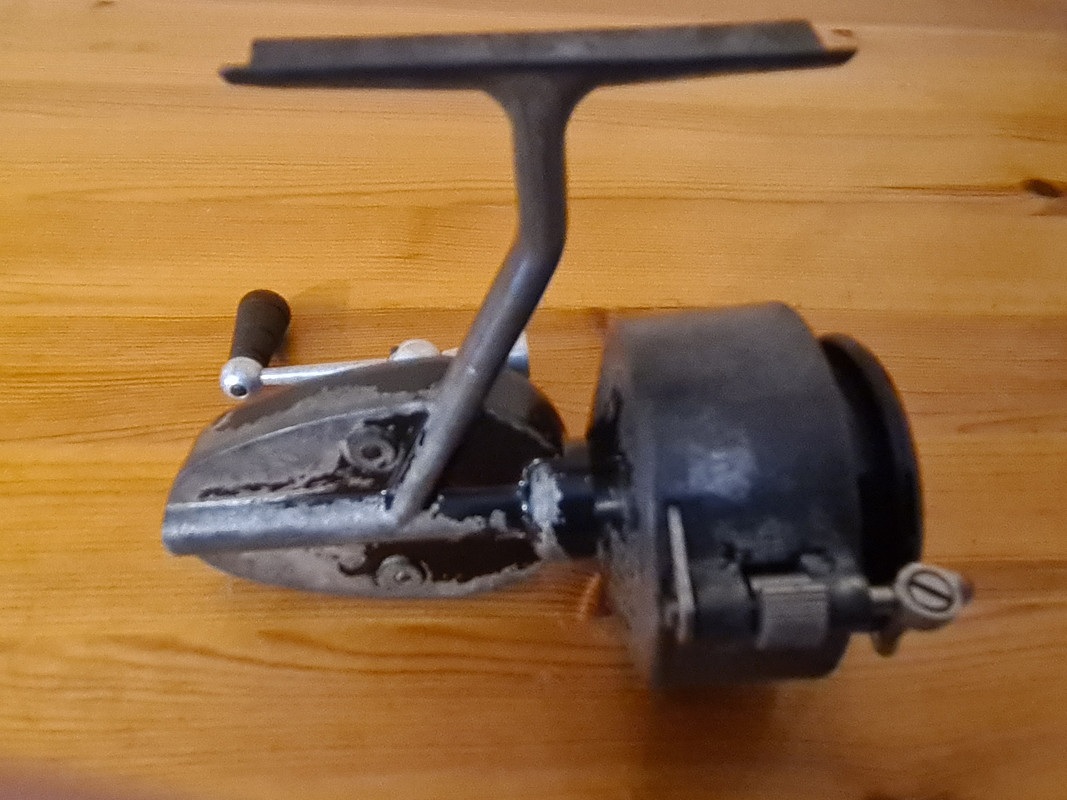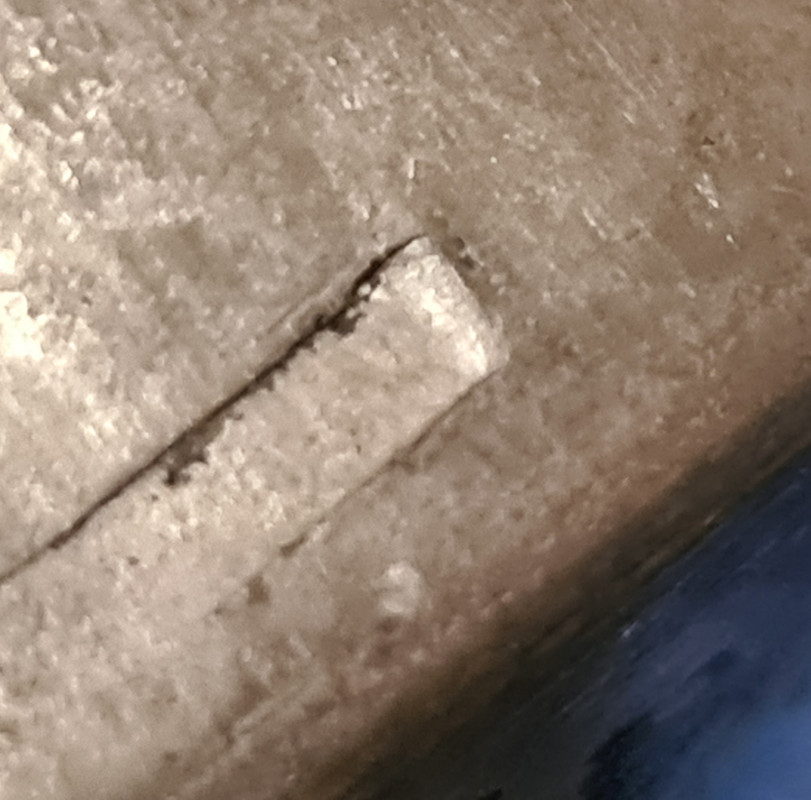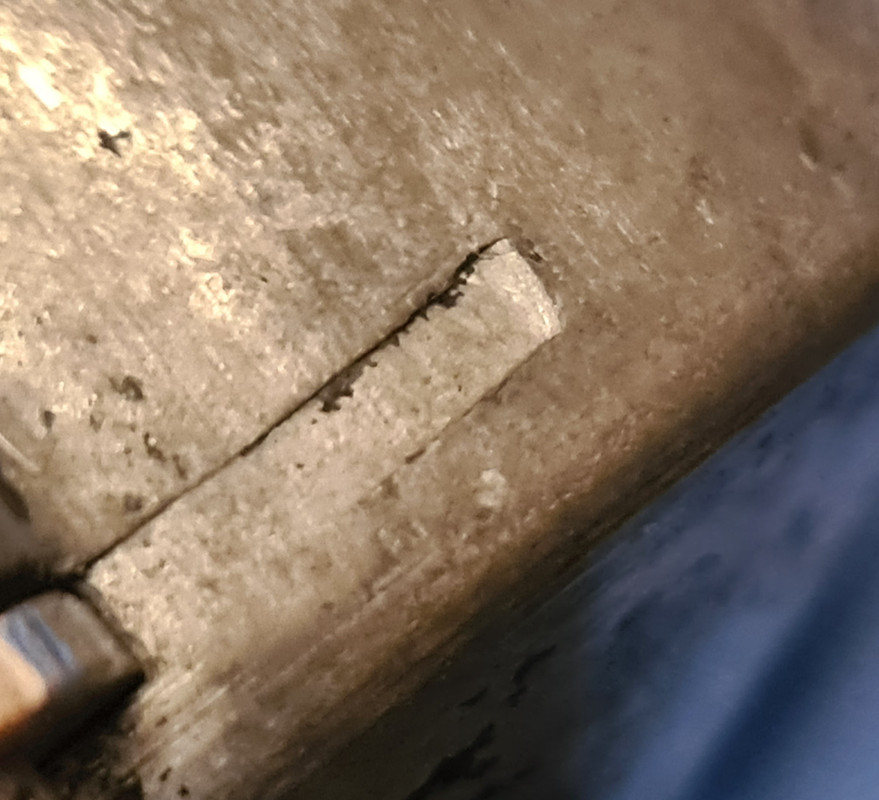I am now the proud custodian of a first version Mitchell. As you all know they are quite rare so I was very pleased to obtain this one .


Kind regards
John


thanks TedTed Lanham wrote: ↑Fri Jun 24, 2022 11:55 am John,
Great find. I'm curious, how did to come across this reel. For many decades I looked for one of these, but never got lucky.
Regards,
Ted Lanham
Hi TedTed Lanham wrote: ↑Fri Jun 24, 2022 11:27 pm JohnEboy,
I believe that those reels are more available across the pond, but you are still lucky to acquire it. They are scarce everywhere.
Regards,
Ted Lanham
Thanks Bill , I'm still excited at the moment and busy comparing with other half bails and having fun inspecting the reel very close up using an illuminated jewellers loupe .. under close examination the body is very interesting even when compared to 2nd's .GreatLaker wrote: ↑Sat Jun 25, 2022 12:23 am John,
Congratulations on a rare find!!
Wonderful to see photographs of first versions as it is a rare treat to many of us. If there is any chance to get a peek on the inside of the housing or inside the rotating head, that would really be a very special occasion.
Kind Regards,
Bill
GreatLaker wrote: ↑Sat Jun 25, 2022 12:23 am John,
Congratulations on a rare find!!
Wonderful to see photographs of first versions as it is a rare treat to many of us. If there is any chance to get a peek on the inside of the housing or inside the rotating head, that would really be a very special occasion.
Kind Regards,
Bill


In some circles people are probably more aware , but most anglers who fish with old tackle probably are still somewhat confused I think .allansharkey wrote: ↑Sun Jul 03, 2022 9:58 am Hi, thanks for posting the pictures, I have had many 2nd versions and many 1st version heads some bodies, normally referred to as using up old stock or transition reels, nice to see the real thing, never seen a complete and real 1st version on eBay in the UK in my time of restoring 11 years, I have had a lot of 2nd version reels come up in job lots, which is a thrill, not for a few years, people are more aware now, sellers and buyers. Allan
Thanks Wayne
Wayne,
GreatLaker wrote: ↑Mon Jul 04, 2022 7:28 pmWayne,
I believe what you are seeing with the counterweight is a repair. Remember when these reels were originally purchased they were for fishing and not for collecting. If something went wrong and it was possible to repair, then it was done. Of course, you could say these reels were guaranteed for life but that only applied to the original purchaser, didn't it?
How the lead counterweights were fastened to the rotor is not well known, if at all. Does anyone reading this know??
Working with lead and attaching it to an aluminum alloy surface might have called for an unconventional method or at least a method we are not familiar with today, I'm guessing.
Wallace, bless him, has shown us that the lead counter weights were welded to the rotor, but how was this done? All I can come up with (guessing and conjecture) is that some kind of pins were formed into the newly made lead counter weights and these were fitted into the holes made in the rotor. Then, somehow high heat (welding) was applied. The outer surface (back side) of the rotating head could then be cleaned of the excess lead left over from the melted pins by sanding or grinding to give the surface a smooth finish and then painted. Of course I'm only guessing and your guess is as good as mine.
But let's say that one of the original lead pins was knocked loose from the mounting hole. Then using a screw to fix a wobbling lead counter weight makes sense to me. How about you?
Kind Regards,
Bill
John,

Sure Bill , I will try and post those images tomorrow.GreatLaker wrote: ↑Tue Jul 05, 2022 8:43 pmJohn,
That is true and that is why I feel your contribution of posting these photos is of such great value and importance.



Not to be greedy but is there any chance we can see more? I would love to see what the lube nut looks like outside the reel. Also what the bare cover plate and housing look like and.......aw heck I want to see everything.

Kind Regards,
Bill

Hi all, Whilst i agree with all the comments I have had many 2nd version reels with 1st version parts, this could be due to early repairers using stock up from broken reels or the factory using up old stock, although from memory this mainly applied to the head popping up frequently which had a pyramid indent to the right of the bail arm lever. I believe the posting on the home page and the book both by Wallace to be the definitive 1st version study, of course there may be some changes during the first version reels life span ie the war as the biggest and possibly using up parts that had been modified or used for experiments or even repaired due to the scarceness of parts and using up parts that were not as they should ie putting a screw in the lead weight, or a later repair in the days you did repair, many theories but a great reel to own, maybe one will turn up herein the UK still pretty much a unicorn, Allan
I found the "pyramid " comment interesting .allansharkey wrote: ↑Fri Jul 08, 2022 10:24 amHi all, Whilst i agree with all the comments I have had many 2nd version reels with 1st version parts, this could be due to early repairers using stock up from broken reels or the factory using up old stock, although from memory this mainly applied to the head popping up frequently which had a pyramid indent to the right of the bail arm lever. I believe the posting on the home page and the book both by Wallace to be the definitive 1st version study, of course there may be some changes during the first version reels life span ie the war as the biggest and possibly using up parts that had been modified or used for experiments or even repaired due to the scarceness of parts and using up parts that were not as they should ie putting a screw in the lead weight, or a later repair in the days you did repair, many theories but a great reel to own, maybe one will turn up herein the UK still pretty much a unicorn, Allan

Hi NobbyBailarm wrote: ↑Sun Jul 10, 2022 1:08 pm I've not heard the 'pyramid' name for the indentation by the bail arm before, but I concluded years ago that it was a pilot to guide the cutting gear in if the reel was to be made as a right hand wind one.
There are at least fourteen first versions in the UK that I know of, I've held four for examination luckily.
They all have differences between one another and that's the problem with the 'versions' way of cataloguing them. Modifications were made over a period of time...just look at the variety of transfer gears, good ness knows what was going on there as they all seem to perform perfectly...even after 70 years.
One writer of a recent book, once a member here, has written in a self-published book of the changes using Mark, or the abbreviation Mk., as is the British way, but I felt it didn't reduce the confusion of 'versions', possibly making it more confusing still.
Consequently, I don't think you can look at a reel and say it isn't this, or it can't be that because of one deviation from Wallace's study which was made some years ago when there just wasn't enough 'firsts' to compare. Wallace did what he could, very thoroughly, with a single reel.
The above mentioned writer has a dozen first versions! All obtained from France, I believe.
Some have primer, some don't. Some have lost a lot of paint, some none at all! They did all have the aluminium rotor gear though.
Inside them is a myriad of minor differences, but one thing caught my eye especially. There were at least two casting dies producing the main body shell, Aluvac casting 4190, using different systems to inject the molten alloy...one with four ports, the other with just two.
Then there is the casting of the main body with the axle mounting shaft/rotor head axle in place before the molten metal was pumped in. No two reels are quite the same here, with the ribbing of the axle shaft often poorly contained within the molten metal. In fact JohnEboy's one above is the best I have seen so far with just a little of the ribbing showing.
Edit:
In addition, I see JohnEboys reel has curved tangs to the anti-reverse lever spring. Some just have a straight bar of spring metal here with no tangs. I've always assumed that to be an early indication, since curved tangs continued on until the first full bails, but it is just as assumption.
One constant was a poorly finished area around the pinion gear axle, with none of the reels having a pinion gear shim washer behind the gear.
.
Bailarm wrote: ↑Sun Jul 10, 2022 1:08 pm I've not heard the 'pyramid' name for the indentation by the bail arm before, but I concluded years ago that it was a pilot to guide the cutting gear in if the reel was to be made as a right hand wind one.....quote]
I agree somewhat with Nobby that the mark or "pyramid" shaped mark was a minor defect. Also agree that the mark was/has been found on first versions as Wallace has pointed out. I believe the "pyramid" nick name was derived by someone looking at the photograph Wallace posted in his first version study here, or in his book titled "The Mitchell Classic 300 Spinning Reel".
You can view this photo right here in the MRM on the Home page under the Studies tab. (see link below)
https://mitchellreelmuseum.com/first-ve ... eel-study/ Scroll down a bit until you come to the heading above the 9th photograph titled "ROTATING HEAD" and look at the photo. You will see that it does indeed look like a pyramid.
This is one great example of how valuable it is to see photos of first version reels and how lucky we are John has shared some of his with us.With John's photographs you can see that the mark is actually more pronounced on his rotor and has a long rectangular shape. Visually cut off the end of John's mark, and it forms a pyramid if lightly struck. This mark was likely made by a machine and was not intentional. Perhaps the machine was out of adjustment and as each rotating head was struck, a different amount of the defect was pressed into the rotating head. Look at 10 first version rotors and all the marks have varying shapes.
Thanks again John, for your generosity.
Kind Regards,
Bill
GreatLaker wrote: ↑Sun Jul 10, 2022 7:36 pmThanks BillBailarm wrote: ↑Sun Jul 10, 2022 1:08 pm I've not heard the 'pyramid' name for the indentation by the bail arm before, but I concluded years ago that it was a pilot to guide the cutting gear in if the reel was to be made as a right hand wind one.....quote]
I agree somewhat with Nobby that the mark or "pyramid" shaped mark was a minor defect. Also agree that the mark was/has been found on first versions as Wallace has pointed out. I believe the "pyramid" nick name was derived by someone looking at the photograph Wallace posted in his first version study here, or in his book titled "The Mitchell Classic 300 Spinning Reel".
You can view this photo right here in the MRM on the Home page under the Studies tab. (see link below)
https://mitchellreelmuseum.com/first-ve ... eel-study/ Scroll down a bit until you come to the heading above the 9th photograph titled "ROTATING HEAD" and look at the photo. You will see that it does indeed look like a pyramid.
This is one great example of how valuable it is to see photos of first version reels and how lucky we are John has shared some of his with us.With John's photographs you can see that the mark is actually more pronounced on his rotor and has a long rectangular shape. Visually cut off the end of John's mark, and it forms a pyramid if lightly struck. This mark was likely made by a machine and was not intentional. Perhaps the machine was out of adjustment and as each rotating head was struck, a different amount of the defect was pressed into the rotating head. Look at 10 first version rotors and all the marks have varying shapes.
Thanks again John, for your generosity.
Kind Regards,
Bill
It really is pleasure to be able to share and discuss these reels and in doing so keep them alive in hearts and minds.
Best wishes
John
HI NobbyBailarm wrote: ↑Mon Jul 11, 2022 8:35 am Not wishing to be argumentative, but one can see the crystalline structure in the slot I believe is a pilot for cutting a rotor for right hand wind. I think that shows us it is cast in, not machined out....though it could be that it is stamped in I admit
I can't see that it could serve any other purpose than to assist in cutting, but as John says, short of time travel will we ever know?
When the first Mitchells were offered for sale most anglers cast with their right hand, then passed the rod to their left hand to wind the reel. I believe many US anglers still do this?
So it seems sensible that should left hand wind not catch on* they be ready to switch to right hand wind promptly.
Interestingly the first full bail reels, that are often referred to as 'pilots' don't have the requisite casting parts for right hand wind and it was only in the first full bails marketed for sale that this was changed. Left hand wind HAD caught on by then so perhaps it wasn't so important in a prototype?
* Garcia even went as far as writing a section in the Mitchell reel owner's manual encouraging anglers to try left hand wind.




Thanks BillGreatLaker wrote: ↑Tue Jul 12, 2022 9:03 pm John,
Thanks for those micro shots they are terrific.
I have now seen all I need to see regarding the mystery defect or "imperfection" as Wallace has so elegantly stated.
Kind Regards,
Bill
be kindRockape wrote: ↑Sun Oct 16, 2022 12:41 pm I just found this thread and I remember watching the auction, congrats on winning it John.
One thing that has me puzzled though, is the bail arm spring type in your 1st version. This is the same type as in my recently acquired 2nd version, but I see Wallace's has the v shaped spring.
Does anyone here know which type came first?
Parts like the springs can easily break over time and be replaced with a more modern version . Similarly with the interchangeability of parts its no surprised people took to upgrading parts , even whole rotating heads like they did from half bail to full bail to have a more modern reel .Rockape wrote: ↑Sun Oct 16, 2022 3:49 pm Hi John,
I already have a shot of the rotor (see below).
To be honest, because the rotor had the suspected alloy gear with the thin brass insert, and everything about the body and rotor (paint finish etc) suggested to me that they were original to each other, I wondered if that part had been changed, so I opened up a couple of A serial numbered reels, which had the same bail spring, so I assumed (not a good thing to do) that at some point the original v shaped spring had broken or maybe someone recommended the loop version and it was changed, so I re-fitted one like that in Wallace's 1st version study from another previously obtained early third version reel (swapped them over).
Sacrelidge maybe? but easily replaced again if I am wrong, so yes we need an expert here to settle this conundrum.
Thanks again for looking and sharing an image , my interest was underneath , one might expect to see a hole where the spring screw goes , and perhaps two circular marks or indentations underneath where the counterweight can be seen inside . If you look to wallace's 1st version study he has these marked with arrows as "two lead welds for the counterweight . In reality the paint is so nice on your reel these may only be barely visible if at all ?Rockape wrote: ↑Sun Oct 16, 2022 3:57 pm It is my understanding that there was some talk during those days of slightly loose bail arms, and that the loop type was better?
Did Mitchell introduce the loop wire to correct the 'inferior' early one, and therefore offer a replacement (any service bulletins on this I wonder).
Who knows, but it does get the old grey matter going.
Edit: I just re-read your post, and you asked if there was anything unusual on the outer drum.
Well there is a small indentation next to the bail trip lever, which is like a small but prominent indented dash line short in length and horizontal in line with the bttom (and top) of the rotor, if that helps (see photo).
Oh thats brilliant Paul , many thanks for doing that .